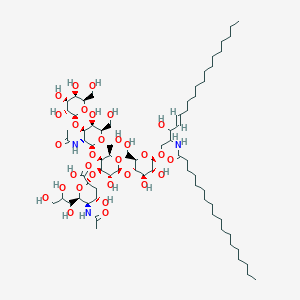Ganglioside GI
Ganglioside GI is a lipid of Sphingolipids (SP) class. Ganglioside gi is associated with abnormalities such as HIV Infections, Amyotrophic Lateral Sclerosis, Neuritis, Motor, Motor Neuron Disease and athymia. The involved functions are known as Gene Expression, antigen binding, Protective Agents, Binding (Molecular Function) and response to hormone stimulus. Ganglioside gi often locates in Membrane, Body tissue, Mucous Membrane, integral to membrane and Virion. The associated genes with Ganglioside GI are Fusion Protein, synthetic peptide, CTBS gene, IL2 gene and CD4 gene. The related lipids are Sphingolipids, sialogangliosides, Membrane Lipids, ganglioside, Gx and polysialoganglioside. The related experimental models are Knock-out, Disease model, Experimental Autoimmune Encephalomyelitis, Rodent Model and Transgenic Model.
References related to genes published in J. Neuroimmunol.
| PMID | Journal | Published Date | Author | Title |
|---|---|---|---|---|
| 26298317 | J. Neuroimmunol. | 2015 | Vlam L et al. | Cytokine profiles in multifocal motor neuropathy and progressive muscular atrophy. |
| 25283719 | J. Neuroimmunol. | 2014 | Notturno F et al. | Autoantibodies to neurofascin-186 and gliomedin in multifocal motor neuropathy. |
| 20920831 | J. Neuroimmunol. | 2010 | Piepers S et al. | IVIg inhibits classical pathway activity and anti-GM1 IgM-mediated complement deposition in MMN. |
| 17161468 | J. Neuroimmunol. | 2007 | van Sorge NM et al. | Leukocyte and complement activation by GM1-specific antibodies is associated with acute motor axonal neuropathy in rabbits. |
| 14698848 | J. Neuroimmunol. | 2004 | Lee G et al. | Induction of human IgM and IgG anti-GM1 antibodies in transgenic mice in response to lipopolysaccharides from Campylobacter jejuni. |
| 11282149 | J. Neuroimmunol. | 2001 | Nobile-Orazio E | Multifocal motor neuropathy. |
| 11240034 | J. Neuroimmunol. | 2001 | Quattrini A et al. | Human IgM anti-GM1 autoantibodies modulate intracellular calcium homeostasis in neuroblastoma cells. |
| 10742560 | J. Neuroimmunol. | 2000 | Lopez PH et al. | Normal human plasma contains antibodies that specifically block neuropathy-associated human anti-GM1 IgG-antibodies. |
